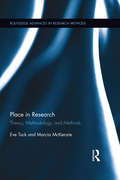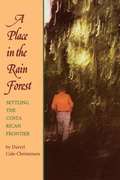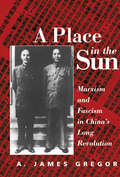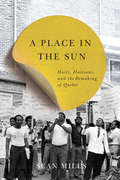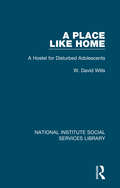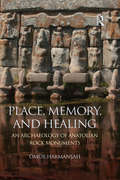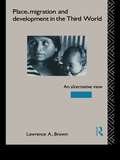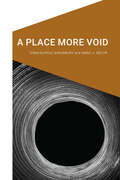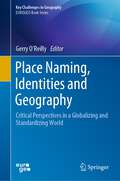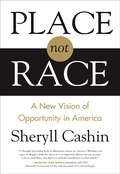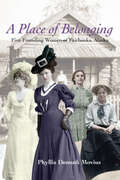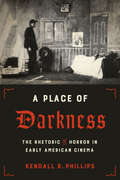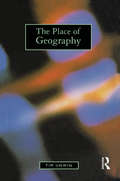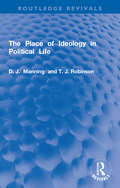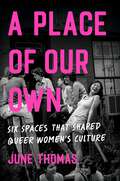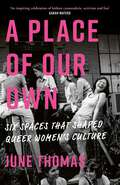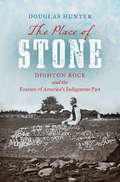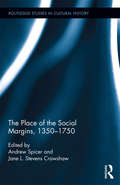- Table View
- List View
Place in Research: Theory, Methodology, and Methods (Routledge Advances in Research Methods #9)
by Eve Tuck Marcia McKenzieBridging environmental and Indigenous studies and drawing on critical geography, spatial theory, new materialist theory, and decolonizing theory, this dynamic volume examines the sometimes overlooked significance of place in social science research. There are often important divergences and even competing logics at work in these areas of research, some which may indeed be incommensurable. This volume explores how researchers around the globe are coming to terms - both theoretically and practically - with place in the context of settler colonialism, globalization, and environmental degradation. Tuck and McKenzie outline a trajectory of critical place inquiry that not only furthers empirical knowledge, but ethically imagines new possibilities for collaboration and action. Critical place inquiry can involve a range of research methodologies; this volume argues that what matters is how the chosen methodology engages conceptually with place in order to mobilize methods that enable data collection and analyses that address place explicitly and politically. Unlike other approaches that attempt to superficially tag on Indigenous concerns, decolonizing conceptualizations of land and place and Indigenous methods are central, not peripheral, to practices of critical place inquiry.
A Place in the Rain Forest: Settling the Costa Rican Frontier
by Darryl Cole-ChristensenIn the 1950s, Darryl Cole-Christensen and his family were among the first settlers of the Coto Brus, an almost impenetrable, mountainous rain forest region of southeastern Costa Rica. In this evocative book, he captures the elemental struggles and rewards of settling a new frontier--an experience forever closed to most people in Western, urbanized society.<P><P>With the perspective of more than forty years' residence in the Coto Brus, Cole-Christensen ably describes both the settlers' dreams of bringing civilization and progress to the rain forest and the sweeping and irreversible changes they caused throughout the ecosystem as they cut the rain forest down. Writing neither to apologize for nor to defend their actions, he instead illuminates the personal and subjective factors that cause people to risk danger and hardship for the uncertain rewards of settling a frontier.
A Place In The Sun: Marxism And Fascimsm In China's Long Revolution
by A. James GregorChina has endured a century of turmoil, beginning with the anti-dynastic revolution associated with Sun Yat-Sen, through the military and tutelary rule of Chiang Kai-shek, the revolutionary regime of Mao Zedong, and the radical reforms of Deng Xiaoping. China has had little respite. Historians and social scientists have attempted to understand some of this history as being the consequence of the impact of European ideologies-including Marxism, Marxism-Leninism, and Fascism. Rarely instructive or persuasive, the discussions regarding this issue have, more often than not, led to puzzlement, rather than enlightenment.In A Place in the Sun, A. James Gregor offers an interpretation of the role of European Marxist and Fascist ideas on China's revolutionaries that is both original, and based on a lifetime of scholarship devoted to revolutionary ideologies. Gregor renders a detailed analysis of their respective influence on major protagonists. In the exposition, Gregor reveals an unsuspected and complex set of relationships between the Chinese revolution and essentially European ideologies. His discussion concludes with a number of estimations that suggest implications for the future of modern China, and its relationship with the advanced industrial democracies. How post-Dengist China-the world's most populous nation-is to be understood remains uncertain to most comparativists and historians. Gregor provides one well supported alternative, and he is carefully attentive to the implications of this alternative.
A Place in the Sun: Haiti, Haitians, and the Remaking of Quebec (Studies on the History of Quebec/Études d'histoire du Québec #31)
by Sean MillsWhat is the relationship between migration and politics in Quebec? How did French Canadians’ activities in the global south influence future debates about migration and Quebec society? How did migrants, in turn, shape debates about language, class, nationalism and sexuality? A Place in the Sun explores these questions through overlapping histories of Quebec and Haiti. From the 1930s to the 1950s, French-Canadian and Haitian cultural and political elites developed close intellectual bonds and large numbers of French-Canadian missionaries began working in the country. Through these encounters, French-Canadian intellectual and religious figures developed an image of Haiti that would circulate widely throughout Quebec and have ongoing cultural ramifications. After first exploring French-Canadian views of Haiti, Sean Mills reverses the perspective by looking at the many ways that Haitian migrants intervened in and shaped Quebec society. As the most significant group seen to integrate into francophone Quebec, Haitian migrants introduced new perspectives into a changing public sphere during decades of political turbulence. By turning his attention to the ideas and activities of Haitian taxi drivers, exiled priests, aspiring authors, dissident intellectuals, and feminist activists, Mills reconsiders the historical actors of Quebec intellectual and political life, and challenges the traditional tendency to view migrants as peripheral to Quebec history. Ranging from political economy to discussions about sexuality, A Place in the Sun demonstrates the ways in which Haitian migrants opened new debates, exposed new tensions, and forever altered Quebec society.
A Place Like Home: A Hostel for Disturbed Adolescents (National Institute Social Services Library)
by W. David WillsThe late David Wills spent a lifetime in the service of the so-called delinquent, the misfit, the maladjusted. He was the first Englishman to train as a psychiatric social worker and was well known for his books The Hawkspur Experiment, The Barns Experiment, etc. Originally published in 1970, this book describes another experiment with a hostel for boys leaving schools for maladjusted children and lacking any settled home from which to enter the community. It demonstrates once again David Wills’s conviction that the offender wants to be ‘good’ and will be helped by affection rather than by punishment. Yet it is obvious that the work was full of stress and that only people with some of the attributes of archangels could respond to the boys’ needs and remain in control of the situation. The book demonstrates the extent of deprivation suffered by such young people and that no ordinary hostels or lodgings will do if they are to be set upon a less turbulent course of life, leading to truly adult independence. It added greatly to our understanding of the personalities, experience of life and needs of maladjusted boys in their ‘teens at the time, although the lessons drawn from it were disturbing in relation both to prevention and treatment. The penetration of David Wills’s assessment is beyond doubt and (as Dame Eileen Younghusband concludes in her Foreword) his book will give a great deal to those ‘trying in various capacities to help boys and girls who otherwise would grow into adulthood permanently handicapped emotionally and socially’. This book is a re-issue originally published in 1970. The language used is a reflection of its era and no offence is meant by the Publishers to any reader by this re-publication.
Place Management and Crime: Ownership and Property Rights as a Source of Social Control (SpringerBriefs in Criminology)
by John E. Eck Shannon J. Linning Tamara D. HeroldThis brief describes the theory and evidence of a form of social control known as place management. Created by property owners, place management is an alternative to the two other domains of social control: formally created by the state and informally created by residents. It helps explain the high concentration of crime and disorder at a relatively small proportion of addresses and facilities. This volume examines the specifics of place management and extends it in three ways: to show how high crime places may radiate crime into their surroundings; to reveal networks of places that create crime hotspot spanning blocks; to demonstrate how networks of place managers influence crime throughout neighborhoods. Finally, it shows that the policy implications of place management extend far beyond the police and should include regulatory policies.
Place Matters
by Weisburd, David and Eck, John E. and Braga, Anthony A. and Telep, Cody W. and Cave, Breanne and Bowers, Kate and Bruinsma, Gerben and Gill, Charlotte and Groff, Elizabeth R. and Hibdon, Julie and Hinkle, Joshua C. and Johnson, Shane D. and Lawton, Brian an David Weisburd John E. Eck Anthony A. Braga Cody W. Telep Breanne Cave Kate Bowers Gerben Bruinsma Charlotte Gill Elizabeth R. Groff Julie Hibdon Joshua C. Hinkle Shane D. Johnson Brian Lawton Cynthia Lum Jerry H. Ratcliffe George Rengert Travis Taniguchi Sue-Ming YangOver the last two decades, there has been increased interest in the distribution of crime and other antisocial behavior at lower levels of geography. The focus on micro geography and its contribution to the understanding and prevention of crime has been called the 'criminology of place'. It pushes scholars to examine small geographic areas within cities, often as small as addresses or street segments, for their contribution to crime. Here, the authors describe what is known about crime and place, providing the most up-to-date and comprehensive review available. Place Matters shows that the study of criminology of place should be a central focus of criminology in the twenty-first century. It creates a tremendous opportunity for advancing our understanding of crime, and for addressing it. The book brings together eighteen top scholars in criminology and place to provide comprehensive research expanding across different themes.
Place, Memory, and Healing: An Archaeology of Anatolian Rock Monuments
by Ömür HarmanşahPlace, Memory, and Healing: An Archaeology of Anatolian Rock Monuments investigates the complex and deep histories of places, how they served as sites of memory and belonging for local communities over the centuries, and how they were appropriated and monumentalized in the hands of the political elites. Focusing on Anatolian rock monuments carved into the living rock at watery landscapes during the Late Bronze and Early Iron Ages, this book develops an archaeology of place as a theory of cultural landscapes and as an engaged methodology of fieldwork in order to excavate the genealogies of places. Advocating that archaeology can contribute substantively to the study of places in many fields of research and engagement within the humanities and the social sciences, this book seeks to move beyond the oft-conceived notion of places as fixed and unchanging, and argues that places are always unfinished, emergent, and hybrid. Rock cut monuments of Anatolian antiquity are discussed in the historical and micro-regional context of their making at the time of the Hittite Empire and its aftermath, while the book also investigates how such rock-cut places, springs, and caves are associated with new forms of storytelling, holy figures, miracles, and healing in their post-antique life. Anybody wishing to understand places of cultural significance both archaeologically as well as through current theoretical lenses such as heritage studies, ethnography of landscapes, social memory, embodied and sensory experience of the world, post-colonialism, political ecology, cultural geography, sustainability, and globalization will find the case studies and research within this book a doorway to exploring places in new and rewarding ways.
Place, Migration and Development in the Third World: An Alternative Perspective
by Lawrence A. BrownProviding a fresh examination of the nature of Third World development, the author focuses on the characteristics of particular places and regions and their influences on behaviour. This is an important study of the relationship between population movements and regional and national changes.
A Place More Void (Cultural Geographies + Rewriting the Earth)
by Paul Kingsbury Anna J. SecorA Place More Void takes its name from a scene in William Shakespeare&’s The Tragedy of Julius Caesar, wherein an elderly soothsayer has a final chance to warn Caesar about the Ides of March. Worried that he won&’t be able to deliver his message because of the crowded alleyways, the soothsayer devises a plan to find and intercept Caesar in &“a place more void.&” It is precisely such an elusive place that this volume makes space for by theorizing and empirically exploring the many yet widely neglected ways in which the void permeates geographical thinking. This collection presents geography&’s most in-depth and sustained engagements with the void to date, demonstrating the extent to which related themes such as gaps, cracks, lacks, and emptiness perforate geography&’s fundamental concepts, practices, and passions. Arranged in four parts around the themes of Holes, Absences, Edges, and Voids, the contributions demonstrate the fecundity of the void for thinking across a wide range of phenomena: from archives to alien abductions, caves to cryptids, and vortexes to vanishing points.A Place More Void gathers established and emerging scholars who engage a wide range of geographical issues and who express themselves not only through archival, literary, and socio-scientific investigations, but also through social and spatial theory, political manifesto, poetry, and performance art.
Place Names of Wisconsin
by Edward CallaryThe colorful history and culture of Wisconsin are reflected in its place names, from those created by Native Americans, French explorers, and diverse European settlers to more recent appellations commemorating political figures, postmasters, and landowners. Organized alphabetically for easy reference, Edward Callary's concise entries reveal the stories behind such intriguing names as Fussville, Misha Mokwa, Couderay, and Thiry Daems. Fun to read and packed with information, Place Names of Wisconsin is a must-have for anyone interested in Wisconsin and Midwest history, language, geography, and culture--or anyone who simply wonders "why did they name it that?"
Place Naming, Identities and Geography: Critical Perspectives in a Globalizing and Standardizing World (Key Challenges in Geography)
by Gerry O’ReillyThis book presents research on geographical naming on land and sea from a wide range of standpoints on: theory and concepts, case studies and education. Space and place naming or toponymy has a long tradition in the sciences and a renewed critical interest in geography and allied disciplines including the humanities. Place: location and cartographical aspects, etymology and geo-histories so salient in past studies, are now being enhanced from a range of radical perspectives, especially in a globalizing, standardizing world with Googlization and the consequent ‘normalization’ of place names, perceptions and images worldwide including those for marketing purposes. Nonetheless, there are conflicting and contesting voices. The interdisciplinary research is enhanced with authors from regional, national and international toponymy-related institutions and organizations including the UNGEGN, IGU, ICA and so forth.
Place, Not Race
by Sheryll CashinFrom a nationally recognized expert, a fresh and original argument for bettering affirmative action Race-based affirmative action had been declining as a factor in university admissions even before the recent spate of related cases arrived at the Supreme Court. Since Ward Connerly kickstarted a state-by-state political mobilization against affirmative action in the mid-1990s, the percentage of four-year public colleges that consider racial or ethnic status in admissions has fallen from 60 percent to 35 percent. Only 45 percent of private colleges still explicitly consider race, with elite schools more likely to do so, although they too have retreated. For law professor and civil rights activist Sheryll Cashin, this isn't entirely bad news, because as she argues, affirmative action as currently practiced does little to help disadvantaged people. The truly disadvantaged--black and brown children trapped in high-poverty environs--are not getting the quality schooling they need in part because backlash and wedge politics undermine any possibility for common-sense public policies. Using place instead of race in diversity programming, she writes, will better amend the structural disadvantages endured by many children of color, while enhancing the possibility that we might one day move past the racial resentment that affirmative action engenders. In Place, Not Race, Cashin reimagines affirmative action and champions place-based policies, arguing that college applicants who have thrived despite exposure to neighborhood or school poverty are deserving of special consideration. Those blessed to have come of age in poverty-free havens are not. Sixty years since the historic decision, we're undoubtedly far from meeting the promise of Brown v. Board of Education, but Cashin offers a new framework for true inclusion for the millions of children who live separate and unequal lives. Her proposals include making standardized tests optional, replacing merit-based financial aid with need-based financial aid, and recruiting high-achieving students from overlooked places, among other steps that encourage cross-racial alliances and social mobility. A call for action toward the long overdue promise of equality, Place, Not Race persuasively shows how the social costs of racial preferences actually outweigh any of the marginal benefits when effective race-neutral alternatives are available.From the Hardcover edition.
A Place of Belonging: Five Founding Women of Fairbanks, Alaska
by Phyllis Demuth MoviusAlaska has always attracted people from varied backgrounds. In A Place of Belonging, Phyllis Movius introduces us to five women who settled in Fairbanks between 1903 and 1923 and who typify the disparate population that has long enriched Alaska. The women’s daily lives and personal stories are woven together in these biographical portraits, drawn from the women’s letters, memoirs, personal papers, club records, their own oral histories and published writings. Enriched by many never-before-published historical photos, Movius’s research gives us a unique inroad into life on the frontier.
A Place of Darkness: The Rhetoric of Horror in Early American Cinema
by Kendall R. Phillips&“An illuminating history . . . it&’s clear that the right story can still terrify us; A Place of Darkness is a primer on how the movies learned to do it.&” —NPR Horror is one of the most enduringly popular genres in cinema. The term &“horror film&” was coined in 1931 between the premiere of Dracula and the release of Frankenstein, but monsters, ghosts, demons, and supernatural and horrific themes have been popular with American audiences since the emergence of novelty cinematographic attractions in the late 1890s. A Place of Darkness illuminates the prehistory of the horror genre by tracing the way horrific elements and stories were portrayed in films prior to the introduction of the term &“horror film.&” Using a rhetorical approach that examines not only early films but also the promotional materials for them and critical responses to them, Kendall R. Phillips argues that the portrayal of horrific elements was enmeshed in broader social tensions around the emergence of American identity and, in turn, American cinema. He shows how early cinema linked monsters, ghosts, witches, and magicians with Old World superstitions and beliefs, in contrast to an American way of thinking that was pragmatic, reasonable, scientific, and progressive. Throughout the teens and twenties, Phillips finds, supernatural elements were almost always explained away as some hysterical mistake, humorous prank, or nefarious plot. The Great Depression of the 1930s, however, constituted a substantial upheaval in the system of American certainty and opened a space for the reemergence of Old-World gothic within American popular discourse in the form of the horror genre, which has terrified and thrilled fans ever since. &“[A] fascinating read.&” —Sublime Horror
A Place of Darkness: The Rhetoric of Horror in Early American Cinema
by Kendall R. Phillips&“An illuminating history . . . it&’s clear that the right story can still terrify us; A Place of Darkness is a primer on how the movies learned to do it.&” —NPR Horror is one of the most enduringly popular genres in cinema. The term &“horror film&” was coined in 1931 between the premiere of Dracula and the release of Frankenstein, but monsters, ghosts, demons, and supernatural and horrific themes have been popular with American audiences since the emergence of novelty cinematographic attractions in the late 1890s. A Place of Darkness illuminates the prehistory of the horror genre by tracing the way horrific elements and stories were portrayed in films prior to the introduction of the term &“horror film.&” Using a rhetorical approach that examines not only early films but also the promotional materials for them and critical responses to them, Kendall R. Phillips argues that the portrayal of horrific elements was enmeshed in broader social tensions around the emergence of American identity and, in turn, American cinema. He shows how early cinema linked monsters, ghosts, witches, and magicians with Old World superstitions and beliefs, in contrast to an American way of thinking that was pragmatic, reasonable, scientific, and progressive. Throughout the teens and twenties, Phillips finds, supernatural elements were almost always explained away as some hysterical mistake, humorous prank, or nefarious plot. The Great Depression of the 1930s, however, constituted a substantial upheaval in the system of American certainty and opened a space for the reemergence of Old-World gothic within American popular discourse in the form of the horror genre, which has terrified and thrilled fans ever since. &“[A] fascinating read.&” —Sublime Horror
The Place of Geography
by Tim UnwinThe Place of Geography is designed to provide a readable and yet challenging account of the emergence of gepgraphy as an academic discipline. It has three particular aims: it seeks to trace the development of geography back to its formal roots in classical antiquity; provides an interpretation of the changes that have taken place in geographical practice within the context of Jurgen Haberma's critical theory; and thirdly, describes how the increasing separation of geography into physical and human parts has been detrimental to our understanding of critical issues concerning the relationship between people and environment.
The Place of Humanities in Our Universities
by Mrinal MiriThis volume examines the critical role of the humanities in universities in India and attempts to redefine its place, meaning and function in education. Bringing together distinguished scholars in the country, it debates the status and predicament of the humanities in the academic programmes within universities. The issues raised here touch upon the entire gamut of problems that a university faces in finding an adequate, rightful and wholesome place for the humanities in its academic curriculum. It discusses the difficulties in the specific identity of disciplines classed under the humanities, the powerful reach of the sciences and technological inroads in the teaching and practice of all disciplines, the relative academic balancing of disciplines in different universities in India, the culture, value and the idea of the university, digitisation of the humanities and online access and their specific impact on research in the concerned disciplines. The volume also presents an instructive debate on the so-called appropriation of traditional social science concerns by other departments. This book will interest those in education, humanities and social sciences, governance and public policy, and South Asian studies.
The Place of Ideology in Political Life (Routledge Revivals)
by D.J. Manning T.J. RobinsonFirst published in 1985, The Place of Ideology in Political Life explores the concept of ‘ideology’ in terms of its philosophical and intellectual underpinnings. Ideology is a term much bandied about by politicians and political thinkers with very little precision employed in its use. Despite acknowledgement in the literature of political studies that ideology plays a part in political life, there exist no precise accounts of the nature of that contribution. This book attempts to take a step towards redressing the balance by determining the sense in which ideology constitutes a genuine form of understanding human relationships and the place understanding has in all political activity regardless of whether or not any particular ideology is to be approved or condemned. This concise work will be invaluable to all students of politics, philosophy of action, ethics, and history of political thought.
The Place of Media Power: Pilgrims and Witnesses of the Media Age (Comedia)
by Nick CouldryThis fascinating study focuses on an area neglected in previous studies of the media: the meetings between ordinary people and the media. Couldry explores what happens when people who normally consume the media witness media processes in action, or even become the object of media attention themselves.
A Place of Our Own: Six Spaces That Shaped Queer Women's Culture
by June ThomasA &“riveting&” and &“indispensable&” (Alison Bechdel) cultural history of queer women&’s lives in the second half of the twentieth century, told through six iconic spaces For as long as queer women have existed, they&’ve created gathering grounds where they can be themselves. From the intimate darkness of the lesbian bar to the sweaty camaraderie of the softball field, these spaces aren&’t a luxury—they&’re a necessity for queer women defining their identities. In A Place of Our Own, journalist June Thomas invites readers into six iconic lesbian spaces over the course of the last sixty years, including the rural commune, the sex toy boutique, the vacation spot, and the feminist bookstore. Thomas blends her own experiences with archival research and rare interviews with pioneering figures like Elaine Romagnoli, Susie Bright, and Jacqueline Woodson. She richly illustrates the lives of the business owners, entrepreneurs, activists, and dreamers who shaped the long struggle for queer liberation. Thomas illuminates what is gained and lost in the shift from the exclusive, tight-knit women&’s spaces of the &’70s toward today&’s more inclusive yet more diffuse LGBTQ+ communities. At once a love letter, a time capsule, and a bridge between generations of queer women, A Place of Our Own brings the history—and timeless present—of the lesbian community to vivid life.
A Place of Our Own: Six Spaces That Shaped Queer Women's Culture - 'An inspiring celebration of lesbian camaraderie, activism and fun' (Sarah Waters)
by June ThomasLesbians are a people without a home. Perhaps that's why the ones we make for ourselves are so important.A highly readable cultural history of queer women's lives in the second half of the twentieth century, told through six iconic spaces'An inspiring celebration of lesbian camaraderie, activism and fun' SARAH WATERS'A cracking read, and a reminder of what shaped where we are now' VAL MCDERMID 'Riveting; indispensable; and suffused with a humane warmth' ALISON BECHDEL'A must-have for any queer bookshelf' TEGAN QUINFor as long as queer women have existed, they've created gathering grounds where they can be themselves. From the intimate darkness of the lesbian bar to the sweaty camaraderie of the softball field, these spaces aren't a luxury - they're a necessity for queer women defining their identities. Blending memoir, archival research and interviews, journalist June Thomas invites readers into six iconic lesbian spaces over the course of the last sixty years, including the rural commune, the sex toy boutique, the holiday destination and the feminist bookstore. She also illuminates what is gained and lost in the shift from the exclusive, tight-knit women's spaces of the '70s toward today's more inclusive yet more diffuse LGBTQ+ communities.'Pulses with delicious dykes and the spaces we have made for ourselves over the years. I welcome this story' STELLA DUFFY'A wonderfully rangy, conversational, and thoughtful exploration of lesbian geographies' DANIEL LAVERY'Immensely readable . . . A celebration of what was - and can be - built, with all the hurdles and ecstasies' ROSIE GARLAND
The Place of Prejudice
by Adam Adatto SandelToday we associate prejudice with ignorance and bigotry and consider it a source of injustice. So how can prejudice have a legitimate place in moral and political judgment? In this ambitious work, Adam Sandel shows that prejudice, properly understood, is not an unfortunate obstacle to clear thinking but an essential aspect of it. The aspiration to reason without preconceptions, he argues, is misguided. Ranging across philosophy from Aristotle to Heidegger and Gadamer, Sandel demonstrates that we inherit our "prejudice against prejudice" from the Enlightenment. By detaching reason from habit and common opinion, thinkers such as Bacon, Descartes, and Kant invented prejudice--as we understand it today--as an obstacle to freedom and a failure to think for oneself. The Place of Prejudice presents a powerful challenge to this picture. The attempt to purge understanding of culture and history leads not to truth, Sandel warns, but to shallowness and confusion. A purely detached notion of reason deprives judgment of all perspective, disparages political rhetoric as mere pandering, and denies us the background knowledge we need to interpret literature, law, and the past. In a clear, eloquent voice, Sandel presents instead a compelling case for reasoning within the world.
The Place of Stone: Dighton Rock and the Erasure of America's Indigenous Past
by Douglas HunterClaimed by many to be the most frequently documented artifact in American archeology, Dighton Rock is a forty-ton boulder covered in petroglyphs in southern Massachusetts. First noted by New England colonists in 1680, the rock's markings have been debated endlessly by scholars and everyday people alike on both sides of the Atlantic. The glyphs have been erroneously assigned to an array of non-Indigenous cultures: Norsemen, Egyptians, Lost Tribes of Israel, vanished Portuguese explorers, and even a prince from Atlantis.In this fascinating story rich in personalities and memorable characters, Douglas Hunter uses Dighton Rock to reveal the long, complex history of colonization, American archaeology, and the conceptualization of Indigenous people. Hunter argues that misinterpretations of the rock's markings share common motivations and have erased Indigenous people not only from their own history but from the landscape. He shows how Dighton Rock for centuries drove ideas about the original peopling of the Americas, including Bering Strait migration scenarios and the identity of the "Mound Builders." He argues the debates over Dighton Rock have served to answer two questions: Who belongs in America, and to whom does America belong?
The Place of the Social Margins, 1350-1750 (Routledge Studies in Cultural History)
by Andrew Spicer Jane L. Stevens CrawshawThis interdisciplinary volume illuminates the shadowy history of the disadvantaged, sick and those who did not conform to the accepted norms of society. It explores how marginal identity was formed, perceived and represented in Britain and Europe during the medieval and early modern periods. It illustrates that the identities of marginal groups were shaped by their place within primarily urban communities, both in terms of their socio-economic status and the spaces in which they lived and worked. Some of these groups – such as executioners, prostitutes, pedlars and slaves – performed a significant social and economic function but on the basis of this were stigmatized by other townspeople. Language was used to control and limit the activities of others within society such as single women and foreigners, as well as the victims of sexual crimes. For many, such as lepers and the disabled, marginal status could be ambiguous, cyclical or short-lived and affected by key religious, political and economic events. Traditional histories have often considered these groups in isolation. Based on new research, a series of case studies from Britain and across Europe illustrate and provide important insights into the problems faced by these marginal groups and the ways in which medieval and early modern communities were shaped and developed.
